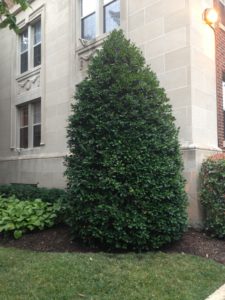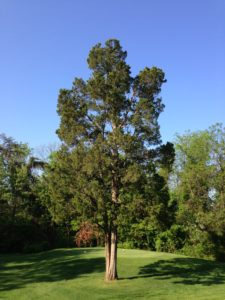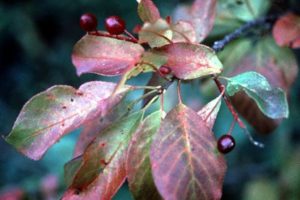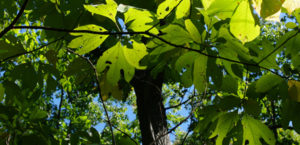THE LEAFLET

The Story on Understory Trees
There are many plant layers to successful ecosystems – from the ground cover, herbaceous plants, shrubs, understory up to the tall canopy layer. Each level plays a vital role in the health of the ecosystem and biodiversity in the landscape, but the understory is an often overlooked layer in our home landscapes. We often plant lush gardens filled with flowering plants, a few ground cover plants, some shrubs and of course we all know the importance of large canopy trees!
The understory level is typically trees ranging in height from 15-49 feet. These understory trees play a vital role in creating a balanced ecosystem by providing food and shelter for much of our wildlife, including birds and small mammals. There are many native understory trees that have high wildlife value as well as providing beauty to your landscape throughout the seasons.

American Holly (ilex opaca)
You will recognize an American Holly by its gray bark and its small and stiff oval-shaped leaves, which have spiny thorns along the edges. The leaves usually grow densely and the tree’s overall shape tends to be pyramidal. When ripe, its small round fruits are usually bright red. White-petaled flowers come out in the spring. It is a small tree, and while it can get over 50 ft. tall, it often grows far shorter than that. It is also the state tree of one of our neighbors – Delaware! This tree is available through our residential planting program, RiverSmart Homes. You can also get up to $50 back for planting this tree yourself through our tree rebate program.

American Hornbeam (Carpinus caroliniana)
The American hornbeam (Carpinus caroliniana) has a variety of alternate names – “Blue Beech,” for the color of its bark, and “Musclewood” for the muscle-like ripples in the trunk. It’s a stately yet humble tree native to the understory of woods and shady areas along streams. It is a member of the birch family and has finely toothed leaves reminiscent of those of birches, though generally smaller in size. This tree is available through our residential planting program, RiverSmart Homes. You can also get up to $50 back for planting this tree yourself through our tree rebate program.

Eastern Red Cedar (Juniperus virginiana L.)
Eastern red cedars are incredibly hardy – resistant to the harsh conditions of cold, heat, and drought, they thrive in a variety of environments: from dry highlands to flood plains and swamps. They’re also incredibly common, as the most widely distributed eastern conifer across 37 states. Other notable features include their aromatic nature – the wood’s strong fragrance actually deters moths and is thus the reason it was often used to line “cedar chests.” This tree is available through our residential planting program, RiverSmart Homes. You can get up to $50 back for planting this tree yourself through our tree rebate program.
 Chokecherry (Prunus virginiana)
Chokecherry (Prunus virginiana)
A small understory tree, chokecherry grows to only 20-30 ft. tall and often forms thickets. Their dense clusters of white flowers are followed by their namesake red chokecherries that ripen to dark purple. As the common name suggests, chokecherries are astringent or puckery, especially when immature or raw, but they actually can be made into preserves and jelly. A heads up – tent caterpillars often construct their silvery webs on the branches of chokecherries.

Sassafras (Sassafras albidum)
An aromatic 35-50 ft. deciduous tree, sassafras trees can grow from shade to sun in moist woodlands and along roadsides and tolerates infertile soil. The sassafras’ brilliant fall foliage and ornamental blooms makes this a particularly attractive addition to your landscape. They’re not just pretty either, Sassafras trees are also an important host plant for several butterflies and moths, including the spicebush swallowtail, pale swallowtail and tiger swallowtail butterflies as well as the promethean silk moth. You can also get up to $100 back for planting this tree yourself through our tree rebate program.